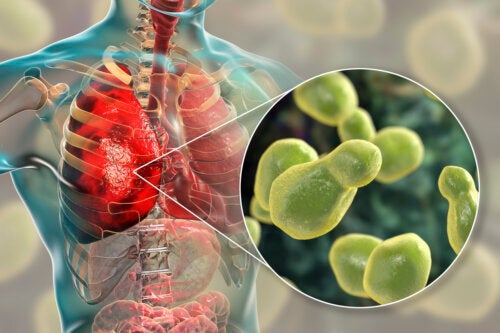Ce sont les 4 champignons les plus dangereux pour la santé selon l'OMS


Rédigé et vérifié par le médecin Leonardo Biolatto
L’Organisation mondiale de la santé (OMS) a préparé un rapport pour répertorier les champignons les plus dangereux pour la santé humaine. Publié en octobre 2022, sous le titre List of Priority Fungal Pathogens to Guide Public Health Research, Development, and Action, le texte identifie trois groupes de ces micro-organismes qui nécessitent une attention particulière.
Après une série de réunions entre spécialistes, il a été établi que 4 des 19 champignons répertoriés méritaient une action prioritaire. En effet, ils ont une plus grande résistance aux médicaments, sont plus meurtriers et laissent des séquelles considérables chez les patients.
Ainsi, les champignons les plus dangereux pour la santé humaine actuellement, selon l’OMS, sont les suivants :
- Candida auris
- Candida albicans
- Aspergillus fumigatus
- Cryptococcus neoformans
Les infections fongiques sont en augmentation et plus résistantes que jamais aux traitements, ce qui en fait un problème mondial de santé publique.[/atomik-quote ]
1. Candida auris, un des champignons les plus dangereux
Ce champignon est l’un des plus dangereux pour la santé humaine, en partie parce qu’il a été découvert si récemment. Le premier enregistrement spécifique date de l’année 2009. Puis, en 2011, un cas d’infection généralisée chez un patient a été signalé. Bien qu’il s’agisse d’un cas isolé, l’année suivante, la première éclosion intrahospitalière due à C. auris a été signalée.
À l’heure actuelle, plus de 40 pays ont déjà signalé des cas avec cet agent pathogène. Le problème est que son caractère émergent et nouveau le rend difficile à identifier avec les méthodes de diagnostic classiques.
Jusqu’à présent, la plupart des patients infectés devaient être traités avec une combinaison d’antifongiques, car les souches avaient tendance à être résistantes aux médicaments. Les statistiques indiquent que, au cours du premier mois de l’évolution de l’infection, jusqu’à 30% des patients meurent.
Depuis son isolement dans le conduit auditif d’une personne en provenance du Japon, les épidémies hospitalières de C. auris ont augmenté. Certains centres de santé ont retrouvé leur présence sur les murs des salles des internats. Et les décès de nouveau-nés au Venezuela, en 2013, ont sans doute été la sonnette d’alarme qui a choqué le monde médical.
Une étude scientifique de 2019 a affirmé que les désinfectants couramment utilisés dans les hôpitaux et les cliniques n’agissent pas contre ce champignon. Par conséquent, des mesures autres que l’antisepsie et la désinfection sont nécessaires pour prévenir les épidémies.
[caption id="attachment_746052" align="aligncenter" width="1254"]
Candida auris.[/caption]Quelle maladie provoque-t-il ?
Selon une publication de Han Du et al., il s’agit de l’un des champignons les plus dangereux pour la santé humaine car on peut le trouver dans différents tissus et sécrétions. Il a déjà été isolé dans le sang, l’urine, la peau et la muqueuse rectale.
Il pourrait se reproduire à l’intérieur du tube digestif et dans des environnements anaérobies, c’est-à-dire sans oxygène ou avec de faibles concentrations de celui-ci. Il a également la capacité de coloniser la muqueuse buccale et, de là, de se propager dans le sang.
[atomik-in-text]Il est considéré comme un pathogène opportuniste.[/atomik-in-text]
Cela signifie qu’il profite d’un système immunitaire affaibli. Pour cette raison, les patients admis dans les unités de soins intensifs sont les plus à risque. Une infection généralisée peut se développer chez eux, conduisant à un état de choc.
[atomik-read-too text="Lisez aussi : " title="Une infection de la bouche pourrait être à l'origine de la maladie d'Alzheimer" url="https://amelioretasante.com/selon-une-etude-une-infection-de-la-bouche-pourrait-etre-a-lorigine-de-la-maladie-dalzheimer/"][/atomik-read-too]
2. Candida albicans fait partie des champignons les plus dangereux
Contrairement au champignon précédent, C. albicans est assez bien connu. Plus facile à diagnostiquer dans ses présentations habituelles, buccale, cutanée et vaginale, il n’en est pas de même du sepsis qu’il peut déclencher chez les sujets sensibles.
Lorsqu’il agit en opportuniste, profitant des défenses amoindries d’un patient, il fait des ravages. Sous sa forme invasive, il atteint le sang et provoque de la fièvre, une insuffisance rénale et une coagulation intravasculaire disséminée (CIVD).
Une attention particulière doit être portée aux personnes recevant un traitement de chimiothérapie pour un cancer. Ils sont particulièrement sensibles à la colonisation par C. albicans. Les longs séjours à l’hôpital et la présence d’un cathéter pour administrer des médicaments par voie intraveineuse facilitent l’arrivée du champignon dans la circulation sanguine.
Il existe trois modalités cliniques invasives les plus classiques et les plus dangereuses de ce champignon :
- Candidémie : le champignon circule dans le sang et se reproduit dans les tissus sanguins. Il y a une septicémie avec fièvre qui entraîne une défaillance des organes ensemble. L’un des plus touchés est le système rénal. De plus, il y a souvent une réaction de formation simultanée de petits caillots dans différentes parties du corps.
- Oesophage : la candidose oesophagienne est la principale cause d’inflammation infectieuse de l’oesophage. Dans les centres de santé où sont effectuées des endoscopies digestives hautes, c’est une préoccupation, car l’instrument de l’étude peut être un véhicule pour le champignon, l’aidant à s’installer dans le tube digestif du patient.
- Rétinienne : l’endophtalmie à Candida provoque des problèmes au niveau de la rétine. Bien qu’il ne s’agisse pas d’une présentation clinique aiguë, son évolution conduit à la cécité s’il n’y a pas de traitement rapide, en raison du fait que la région interne du globe oculaire est remplie de cicatrices qui obscurcissent la vision.
[caption id="attachment_700826" align="aligncenter" width="2508"]
Candida albicans.[/caption]3. Aspergillus fumigatus
Une revue de 1999 a mis en garde contre A. fumigatus comme l’un des champignons les plus dangereux pour la santé humaine. Capable de survivre au sol et dans des environnements difficiles, il a le pouvoir de contourner les défenses humaines avec une relative facilité lorsque l’immunité est mise à l’épreuve.
Bien qu’opportuniste, sa transmission aérienne est souvent inquiétante. Pour cette raison, c’est l’un des agents pathogènes les plus recherchés chez les patients qui présentent des symptômes respiratoires dans le cadre d’une maladie immunosuppressive.
La forme pulmonaire n’est pas toujours la même et, bien qu’elle soit désignée sous le nom d’aspergillose de manière générique, il faut distinguer la présentation allergique, chronique et aspergillomateuse. À son tour, l’allergie a deux autres sous-formes. L’un d’eux est le broncho-pulmonaire ou ABPA, qui se compose de symptômes très similaires à l’asthme. L’autre est la sinusite causée par A. fumigatus, qui provoque du mucus, une congestion nasale et une capacité réduite à sentir.
De son côté, un aspergillome est une tumeur formée par une agglomération de champignons. Il occupe un espace dans le poumon et agit comme un nodule, capable de déclencher une toux et une dyspnée ou un essoufflement.
La forme chronique n’est pas rare chez les personnes dont le système immunitaire n’est pas compromis. Le champignon colonise lentement la muqueuse des bronches et provoque des réactions à long terme. À notre connaissance, jusqu’à un tiers des patients atteints de maladie pulmonaire obstructive chronique (MPOC) sont colonisés par le champignon.
Comment est-il traité ?
L’approche de l’aspergillose dépend de sa présentation. Les formes allergiques répondent généralement bien à l’itraconazole, parfois associé à un corticoïde pour gérer les symptômes de la réaction générée au niveau du système respiratoire.
Si l’agent pathogène a envahi les organes et le sang, des combinaisons de médicaments plus puissantes sont nécessaires. Le voriconazole, l’amphotéricine et la capsofongine font partie de ceux choisis.
[caption id="attachment_746069" align="aligncenter" width="1200"]
Aspergillus fumigatus.[/caption]4. Cryptococcus neoformans
La maladie connue sous le nom de cryptococcose peut être causée par ce champignon ou par C. gattii. La seconde semble limitée à certaines zones géographiques du monde, alors que C. neoformans a une présence mondiale.
Comme A. fumigatus, sa présence dans le sol le rend accessible à l’inhalation. Il a été localisé dans certaines espèces d’arbres et expulsé par les excréments d’oiseaux. Et comme d’autres agents pathogènes opportunistes, il profite de l’affaiblissement du système immunitaire chez les patients atteints du VIH/sida, d’un cancer ou d’une greffe.
Selon les statistiques, 223 000 personnes sont diagnostiquées chaque année d’une méningite due à ce champignon. Il s’agit de la première cause de mortalité chez les patients immunodéprimés, puisque plus de 180 000 meurent de l’infection chaque année.
Bien qu’il soit sensible à trois groupes différents de médicaments antifongiques, sa capacité de résistance est de plus en plus détectée. Les chercheurs pensent que l’un de ses mécanismes de défense est l’hybridation, c’est-à-dire le mélange génétique avec d’autres souches. Il est également suggéré que l’utilisation excessive de pesticides dans l’agriculture contribue au processus.
[atomik-read-too text="Lisez aussi : " title="Les symptômes des principales maladies cardiaques chez les femmes" url="https://amelioretasante.com/symptomes-des-principales-maladies-cardiaques-chez-les-femmes/"][/atomik-read-too]
Le cas particulier des patients séropositifs
La cryptococcose méningée chez les patients infectés par le VIH est un grave problème de santé publique. C’est l’une des complications les plus mortelles pour ces personnes et sa détection précoce peut signifier que des vies sont sauvées.
Cependant, il existe un autre facteur de risque lié à la maladie sous-jacente elle-même. Ceux qui ne sont pas sous traitement antirétroviral (ART) ou qui viennent de le commencer sont plus susceptibles de mourir s’ils contractent le champignon. C’est pourquoi il est essentiel qu’il y ait un accès rapide et équitable à l’ART.
[caption id="attachment_746068" align="aligncenter" width="1254"]
Cryptococcus neoformans.[/caption]Les champignons les plus dangereux pour la santé doivent faire l’objet de recherches
La liste des champignons les plus dangereux pour la santé humaine a été publiée afin de promouvoir la recherche dans ce domaine. De nouveaux développements devraient résoudre le problème de la résistance aux antifongiques.
En attendant, la protection des patients immunodéprimés et de ceux qui sont hospitalisés est une priorité. Prendre soin des groupes à risque réduit la propagation de ces agents pathogènes difficiles à diagnostiquer.
En plus des quatre champignons que nous avons mentionnés, les 15 autres qui composent la liste de l’OMS sont les suivants :
- Deuxième groupe prioritaire : Nakaseomyces glabrata, Histoplasma spp., Eumycétome, Mucorales, Fusarium spp., Candida tropicalis, Candida parapsilosis.
- Groupe de priorité moyenne : Scedosporium spp., Lomentospora prolificans, Coccidioides spp., Pichia kudriavzeveii, Cryptococcus gattii, Talaromyces marneffei, Pneumocystis jirovecii, Paracoccidioides spp.
[atomik-quote author="Haileyesus Getahun, directeur de l'OMS pour la coordination mondiale de la résistance aux antimicrobiens"]Nous avons besoin de plus de données et d’informations sur les infections fongiques et la résistance aux antifongiques pour guider et améliorer la réponse à ces pathogènes fongiques prioritaires.
L’Organisation mondiale de la santé (OMS) a préparé un rapport pour répertorier les champignons les plus dangereux pour la santé humaine. Publié en octobre 2022, sous le titre List of Priority Fungal Pathogens to Guide Public Health Research, Development, and Action, le texte identifie trois groupes de ces micro-organismes qui nécessitent une attention particulière.
Après une série de réunions entre spécialistes, il a été établi que 4 des 19 champignons répertoriés méritaient une action prioritaire. En effet, ils ont une plus grande résistance aux médicaments, sont plus meurtriers et laissent des séquelles considérables chez les patients.
Ainsi, les champignons les plus dangereux pour la santé humaine actuellement, selon l’OMS, sont les suivants :
- Candida auris
- Candida albicans
- Aspergillus fumigatus
- Cryptococcus neoformans
Les infections fongiques sont en augmentation et plus résistantes que jamais aux traitements, ce qui en fait un problème mondial de santé publique.[/atomik-quote ]
1. Candida auris, un des champignons les plus dangereux
Ce champignon est l’un des plus dangereux pour la santé humaine, en partie parce qu’il a été découvert si récemment. Le premier enregistrement spécifique date de l’année 2009. Puis, en 2011, un cas d’infection généralisée chez un patient a été signalé. Bien qu’il s’agisse d’un cas isolé, l’année suivante, la première éclosion intrahospitalière due à C. auris a été signalée.
À l’heure actuelle, plus de 40 pays ont déjà signalé des cas avec cet agent pathogène. Le problème est que son caractère émergent et nouveau le rend difficile à identifier avec les méthodes de diagnostic classiques.
Jusqu’à présent, la plupart des patients infectés devaient être traités avec une combinaison d’antifongiques, car les souches avaient tendance à être résistantes aux médicaments. Les statistiques indiquent que, au cours du premier mois de l’évolution de l’infection, jusqu’à 30% des patients meurent.
Depuis son isolement dans le conduit auditif d’une personne en provenance du Japon, les épidémies hospitalières de C. auris ont augmenté. Certains centres de santé ont retrouvé leur présence sur les murs des salles des internats. Et les décès de nouveau-nés au Venezuela, en 2013, ont sans doute été la sonnette d’alarme qui a choqué le monde médical.
Une étude scientifique de 2019 a affirmé que les désinfectants couramment utilisés dans les hôpitaux et les cliniques n’agissent pas contre ce champignon. Par conséquent, des mesures autres que l’antisepsie et la désinfection sont nécessaires pour prévenir les épidémies.
[caption id="attachment_746052" align="aligncenter" width="1254"]
Candida auris.[/caption]Quelle maladie provoque-t-il ?
Selon une publication de Han Du et al., il s’agit de l’un des champignons les plus dangereux pour la santé humaine car on peut le trouver dans différents tissus et sécrétions. Il a déjà été isolé dans le sang, l’urine, la peau et la muqueuse rectale.
Il pourrait se reproduire à l’intérieur du tube digestif et dans des environnements anaérobies, c’est-à-dire sans oxygène ou avec de faibles concentrations de celui-ci. Il a également la capacité de coloniser la muqueuse buccale et, de là, de se propager dans le sang.
[atomik-in-text]Il est considéré comme un pathogène opportuniste.[/atomik-in-text]
Cela signifie qu’il profite d’un système immunitaire affaibli. Pour cette raison, les patients admis dans les unités de soins intensifs sont les plus à risque. Une infection généralisée peut se développer chez eux, conduisant à un état de choc.
[atomik-read-too text="Lisez aussi : " title="Une infection de la bouche pourrait être à l'origine de la maladie d'Alzheimer" url="https://amelioretasante.com/selon-une-etude-une-infection-de-la-bouche-pourrait-etre-a-lorigine-de-la-maladie-dalzheimer/"][/atomik-read-too]
2. Candida albicans fait partie des champignons les plus dangereux
Contrairement au champignon précédent, C. albicans est assez bien connu. Plus facile à diagnostiquer dans ses présentations habituelles, buccale, cutanée et vaginale, il n’en est pas de même du sepsis qu’il peut déclencher chez les sujets sensibles.
Lorsqu’il agit en opportuniste, profitant des défenses amoindries d’un patient, il fait des ravages. Sous sa forme invasive, il atteint le sang et provoque de la fièvre, une insuffisance rénale et une coagulation intravasculaire disséminée (CIVD).
Une attention particulière doit être portée aux personnes recevant un traitement de chimiothérapie pour un cancer. Ils sont particulièrement sensibles à la colonisation par C. albicans. Les longs séjours à l’hôpital et la présence d’un cathéter pour administrer des médicaments par voie intraveineuse facilitent l’arrivée du champignon dans la circulation sanguine.
Il existe trois modalités cliniques invasives les plus classiques et les plus dangereuses de ce champignon :
- Candidémie : le champignon circule dans le sang et se reproduit dans les tissus sanguins. Il y a une septicémie avec fièvre qui entraîne une défaillance des organes ensemble. L’un des plus touchés est le système rénal. De plus, il y a souvent une réaction de formation simultanée de petits caillots dans différentes parties du corps.
- Oesophage : la candidose oesophagienne est la principale cause d’inflammation infectieuse de l’oesophage. Dans les centres de santé où sont effectuées des endoscopies digestives hautes, c’est une préoccupation, car l’instrument de l’étude peut être un véhicule pour le champignon, l’aidant à s’installer dans le tube digestif du patient.
- Rétinienne : l’endophtalmie à Candida provoque des problèmes au niveau de la rétine. Bien qu’il ne s’agisse pas d’une présentation clinique aiguë, son évolution conduit à la cécité s’il n’y a pas de traitement rapide, en raison du fait que la région interne du globe oculaire est remplie de cicatrices qui obscurcissent la vision.
[caption id="attachment_700826" align="aligncenter" width="2508"]
Candida albicans.[/caption]3. Aspergillus fumigatus
Une revue de 1999 a mis en garde contre A. fumigatus comme l’un des champignons les plus dangereux pour la santé humaine. Capable de survivre au sol et dans des environnements difficiles, il a le pouvoir de contourner les défenses humaines avec une relative facilité lorsque l’immunité est mise à l’épreuve.
Bien qu’opportuniste, sa transmission aérienne est souvent inquiétante. Pour cette raison, c’est l’un des agents pathogènes les plus recherchés chez les patients qui présentent des symptômes respiratoires dans le cadre d’une maladie immunosuppressive.
La forme pulmonaire n’est pas toujours la même et, bien qu’elle soit désignée sous le nom d’aspergillose de manière générique, il faut distinguer la présentation allergique, chronique et aspergillomateuse. À son tour, l’allergie a deux autres sous-formes. L’un d’eux est le broncho-pulmonaire ou ABPA, qui se compose de symptômes très similaires à l’asthme. L’autre est la sinusite causée par A. fumigatus, qui provoque du mucus, une congestion nasale et une capacité réduite à sentir.
De son côté, un aspergillome est une tumeur formée par une agglomération de champignons. Il occupe un espace dans le poumon et agit comme un nodule, capable de déclencher une toux et une dyspnée ou un essoufflement.
La forme chronique n’est pas rare chez les personnes dont le système immunitaire n’est pas compromis. Le champignon colonise lentement la muqueuse des bronches et provoque des réactions à long terme. À notre connaissance, jusqu’à un tiers des patients atteints de maladie pulmonaire obstructive chronique (MPOC) sont colonisés par le champignon.
Comment est-il traité ?
L’approche de l’aspergillose dépend de sa présentation. Les formes allergiques répondent généralement bien à l’itraconazole, parfois associé à un corticoïde pour gérer les symptômes de la réaction générée au niveau du système respiratoire.
Si l’agent pathogène a envahi les organes et le sang, des combinaisons de médicaments plus puissantes sont nécessaires. Le voriconazole, l’amphotéricine et la capsofongine font partie de ceux choisis.
[caption id="attachment_746069" align="aligncenter" width="1200"]
Aspergillus fumigatus.[/caption]4. Cryptococcus neoformans
La maladie connue sous le nom de cryptococcose peut être causée par ce champignon ou par C. gattii. La seconde semble limitée à certaines zones géographiques du monde, alors que C. neoformans a une présence mondiale.
Comme A. fumigatus, sa présence dans le sol le rend accessible à l’inhalation. Il a été localisé dans certaines espèces d’arbres et expulsé par les excréments d’oiseaux. Et comme d’autres agents pathogènes opportunistes, il profite de l’affaiblissement du système immunitaire chez les patients atteints du VIH/sida, d’un cancer ou d’une greffe.
Selon les statistiques, 223 000 personnes sont diagnostiquées chaque année d’une méningite due à ce champignon. Il s’agit de la première cause de mortalité chez les patients immunodéprimés, puisque plus de 180 000 meurent de l’infection chaque année.
Bien qu’il soit sensible à trois groupes différents de médicaments antifongiques, sa capacité de résistance est de plus en plus détectée. Les chercheurs pensent que l’un de ses mécanismes de défense est l’hybridation, c’est-à-dire le mélange génétique avec d’autres souches. Il est également suggéré que l’utilisation excessive de pesticides dans l’agriculture contribue au processus.
[atomik-read-too text="Lisez aussi : " title="Les symptômes des principales maladies cardiaques chez les femmes" url="https://amelioretasante.com/symptomes-des-principales-maladies-cardiaques-chez-les-femmes/"][/atomik-read-too]
Le cas particulier des patients séropositifs
La cryptococcose méningée chez les patients infectés par le VIH est un grave problème de santé publique. C’est l’une des complications les plus mortelles pour ces personnes et sa détection précoce peut signifier que des vies sont sauvées.
Cependant, il existe un autre facteur de risque lié à la maladie sous-jacente elle-même. Ceux qui ne sont pas sous traitement antirétroviral (ART) ou qui viennent de le commencer sont plus susceptibles de mourir s’ils contractent le champignon. C’est pourquoi il est essentiel qu’il y ait un accès rapide et équitable à l’ART.
[caption id="attachment_746068" align="aligncenter" width="1254"]
Cryptococcus neoformans.[/caption]Les champignons les plus dangereux pour la santé doivent faire l’objet de recherches
La liste des champignons les plus dangereux pour la santé humaine a été publiée afin de promouvoir la recherche dans ce domaine. De nouveaux développements devraient résoudre le problème de la résistance aux antifongiques.
En attendant, la protection des patients immunodéprimés et de ceux qui sont hospitalisés est une priorité. Prendre soin des groupes à risque réduit la propagation de ces agents pathogènes difficiles à diagnostiquer.
En plus des quatre champignons que nous avons mentionnés, les 15 autres qui composent la liste de l’OMS sont les suivants :
- Deuxième groupe prioritaire : Nakaseomyces glabrata, Histoplasma spp., Eumycétome, Mucorales, Fusarium spp., Candida tropicalis, Candida parapsilosis.
- Groupe de priorité moyenne : Scedosporium spp., Lomentospora prolificans, Coccidioides spp., Pichia kudriavzeveii, Cryptococcus gattii, Talaromyces marneffei, Pneumocystis jirovecii, Paracoccidioides spp.
[atomik-quote author="Haileyesus Getahun, directeur de l'OMS pour la coordination mondiale de la résistance aux antimicrobiens"]Nous avons besoin de plus de données et d’informations sur les infections fongiques et la résistance aux antifongiques pour guider et améliorer la réponse à ces pathogènes fongiques prioritaires.
Toutes les sources citées ont été examinées en profondeur par notre équipe pour garantir leur qualité, leur fiabilité, leur actualité et leur validité. La bibliographie de cet article a été considérée comme fiable et précise sur le plan académique ou scientifique
- Alastruey-Izquierdo, Ana, World Health Organization, and World Health Organization. “WHO fungal priority pathogens list to guide research, development and public health action.” (2022).
- Bouchentouf, Rachid. “Aspergiloma pulmonar bilateral.” Revista de la Sociedad Peruana de Medicina Interna 34.2 (2021): 87-87.
- Collado-Chagoya, Rodrigo, et al. “Aspergilosis broncopulmonar alérgica.” Medicina Interna de México 37.1 (2021): 144-151.
- Du, Han, et al. “Candida auris: Epidemiology, biology, antifungal resistance, and virulence.” PLoS pathogens 16.10 (2020): e1008921.
- Fúnez-Madrid, Víctor H., et al. “Candidiasis esofágica: Análisis descriptivo en un centro de referencia endoscópica.” Endoscopia 32 (2020): 415-415.
- Geddes-McAlister, J. and Shapiro, R.S. (2018) New pathogens, new tricks: emerging, drug-resistant fungal pathogens and future prospects for antifungal therapeutics. Annals of the New York Academy of Sciences, 1435(1), 57–78. https://doi.org/10.1111/nyas.13739
- Latgé, Jean-Paul. “Aspergillus fumigatus and aspergillosis.” Clinical microbiology reviews 12.2 (1999): 310-350.
- Lizarazo, Jairo, and Elizabeth Castañeda. “Consideraciones sobre la criptococosis en los pacientes con sida.” Infectio 16.3S (2012).
- May, R.C., Stone, N.R.H., Wiesner, D.L., Bicanic, T. and Nielsen, K. (2016) Cryptococcus: from environmental saprophyte to global pathogen. Nature Reviews Microbiology, 14(2), 106–117. https://doi.org/10.1038/nrmicro.2015.6
- Méndez-Tovar, Luis Javier, et al. “Candidiasis esofágica en pacientes de un hospital de especialidades.” Revista Médica del Instituto Mexicano del Seguro Social 57.2 (2019): 74-81.
- Mourad, A. and Perfect, J.R. (2018) Present and future therapy of Cryptococcus infections. Journal of Fungi, 4(3), 79. https://doi.org/10.3390/jof4030079
- Pashley, Catherine H., et al. “Routine processing procedures for isolating filamentous fungi from respiratory sputum samples may underestimate fungal prevalence.” Medical mycology 50.4 (2012): 433-438.
- Perera, Sandra Gómez, et al. “Endoftalmitis endógena por cándida álbicans: a propósito de un caso.” Archivos de la Sociedad Canaria de Oftalmología 32 (2021): 7-12.
- Rajasingham, R., Smith, R.M., Park, B.J., Jarvis, J.N., Govender, N.P., Chiller, T.M., et al. (2017) Global burden of disease of HIV-associated cryptococcal meningitis: an updated analysis. The Lancet Infectious Diseases, 17(8), 873–881. https://doi.org/10.1016/S1473-3099(17)30243-8
- Rhodes, Johanna, and Matthew C. Fisher. “Global epidemiology of emerging Candida auris.” Current opinion in microbiology 52 (2019): 84-89.
- Satoh, Kazuo, et al. “Candida auris sp. nov., a novel ascomycetous yeast isolated from the external ear canal of an inpatient in a Japanese hospital.” Microbiology and immunology 53.1 (2009): 41-44.
Ce texte est fourni à des fins d'information uniquement et ne remplace pas la consultation d'un professionnel. En cas de doute, consultez votre spécialiste.











